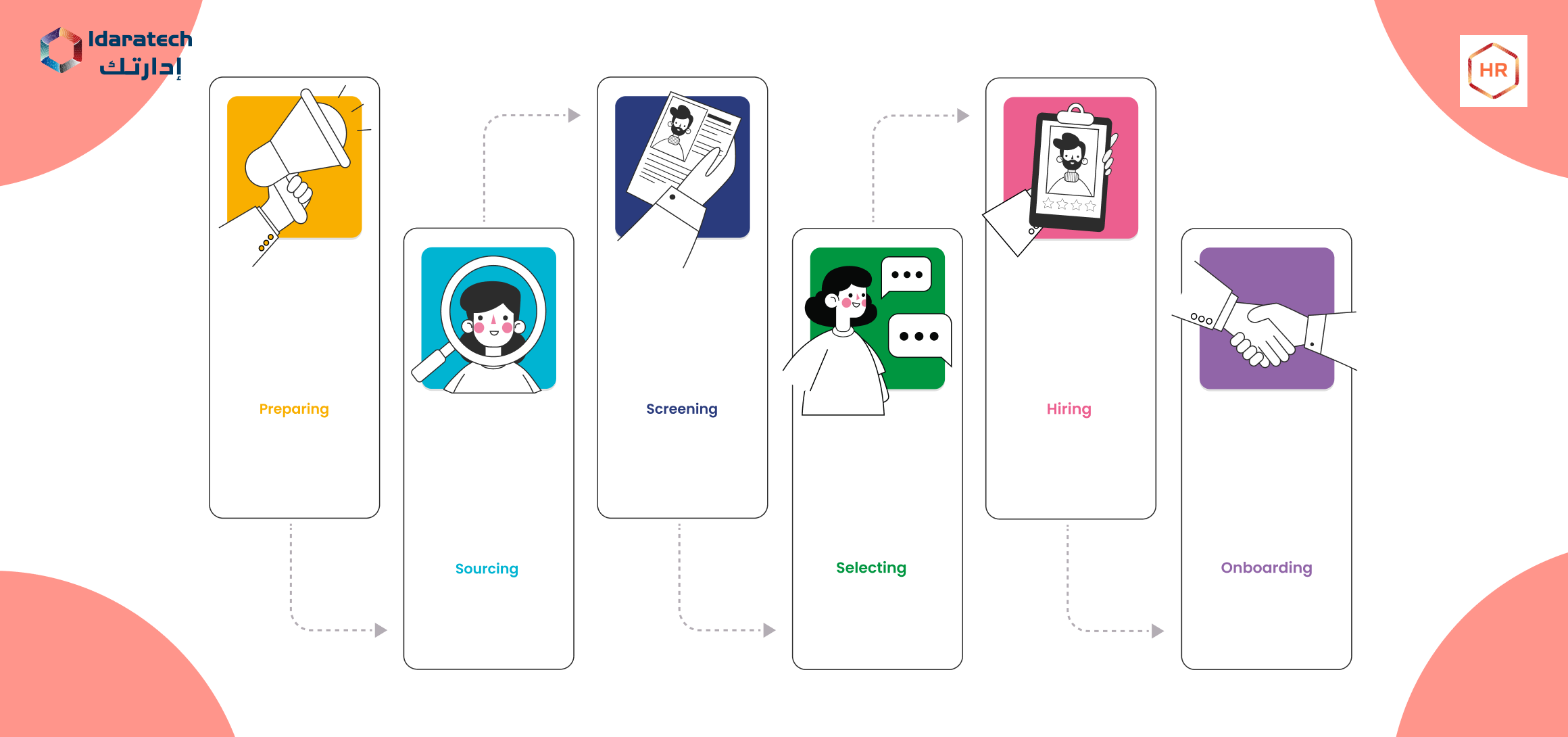The lifeblood of any employment company is recruiting. Therefore, any company must have a plan to constantly entice and keep top people while assuring optimal resource use. Designing a plan around the recruitment life cycle is one of the best methods to boost profitability and remain on top of trends.
Therefore, sales, recruitment, and human resource management procedures are necessary for every successful staffing plan.
Let’s now examine in detail what a recruitment life cycle is and what are the steps for the recruitment cycle to accomplish your business objectives.
What is the Recruitment Cycle?

The hiring or placement of the candidate marks the completion of the recruiting life cycle, which starts when there is a demand or requirement for a candidate. It covers everything, from the first second you determine you need a new worker to the onboarding procedure for your new job.
When the cycle is complete, we begin the process all over again. You may standardize your employment procedure as a result. Additionally, it enables you to continuously improve your hiring procedures to select candidates with ever-higher standards and commit fewer errors.
The hiring process for every employee benefits from the recruitment life cycle. This procedure can increase your chances of discovering exceptional talent, whether you’re searching for part-time staff for your customer care department or your next CEO.
Steps for Recruitment Cycle
The complete recruitment life cycle involves handling and managing various hiring stages. End-to-end recruitment is exactly that. As we all know, there are various steps to the hiring process. Here are the seven recruitment steps crucial to a successful hiring process.
How does the end-to-end recruitment system work?
1. Determine the need for recruiting:
Identifying a need within your organization is the first step in the hiring process. This need could be anything from expanding the scope of organizational activities to better managing the workload of a team or filling an open job. In other words, positions are either newly created or recently vacated.
2. Create A Recruitment Strategy:
An organization should start recruiting as soon as a hiring need is identified. Organizations should show how newly created positions fit their objectives and business strategy. At each stage of the hiring process, organizations should inform the pertinent internal teams and staff of the new role. Everyone involved in the hiring process must accept the steps in the hiring process and the appropriate routes for communication. The recruitment process also entails planning how to advertise the new post internally and externally, the standards for initial candidate screening, the format of the interview process, and who will conduct the interviews.
3. Construct a job description:
The hiring team should create a job description containing a prioritized list of the position’s prerequisites, unique requirements, desired traits, and required experience. Salary and benefit details should be included in the job description as well.
4. Promotion of the Position:
Starting from within, find highly competent potential applicants. Therefore, you should start by informing present workers about the position. If you fill the position internally, you might stop advertising the job. However, when you tell internally, you should mention this information if you are interested in external prospects. A combination of the company’s website and social media platforms, job posting websites like LinkedIn, job fairs, industry journals and events, local newspaper adverts, and word-of-mouth recruiting will likely be used for external publicity. The company’s website, social media platforms, and job-posting websites like LinkedIn, trade journals, and local newspaper adverts will probably all be used for publicity.
5. Recruit the Position:
The hiring team should directly contact suitable prospects via LinkedIn, social media, and job fairs in addition to posting jobs. Active recruitment will assist in generating applications from possible applicants who may be ideal for the open position but are not actively looking for new employment.
6. Examine Applications:
It’s likely that your company already has a system in place for accepting applications, such as an applicant tracking system (ATS) or email. Human resource professionals frequently analyze the applications to start the review process and weed out any applicants who don’t fit the bill for the job or the organization as a whole. Sometimes, the hiring group or manager may favor reviewing each applicant. The hiring team should analyze the remaining applicants and choose those they want to interview after assembling a batch of qualified applications.
7. Initial Phone Interview/Screening:
Typically, phone calls with HR officials precede initial interviews. Candidates are evaluated via phone interviews to see if they meet the job requirements and fit with the culture and values of the firm. Phone interviews let employers efficiently use corporate resources while narrowing the pool of candidates.
8. Interviews:
For those remaining candidates, one or more interviews are planned, depending on the size of the hiring committee and organization. Interviews with:
- Early interviews are usually in person, one-on-one, between candidates and the hiring manager. Early interview discussions frequently center on the experience, abilities, employment history, and availability of applicants.
- The hiring committee may conduct additional one-on-one or group interviews with management, staff, executives, and other company members. They can take place on-site, off-site, or online via Skype, Google Hangouts, etc. Additional interviews are more in-depth; for instance, when a candidate is interviewed by more than one member of the hiring team, each member of the hiring team focuses on a different subject or aspect of the job to avoid repetition and guarantee a thorough discussion of the position and the candidate’s credentials and experience.
- Final interviews frequently involve a deeper discussion with an interviewer from an earlier stage of the employment process or interactions with senior leadership from the organization. Only a relatively limited number of the best candidates are usually invited for final interviews.
9. Evaluation of the Candidate:
Companies frequently give candidates one or more standardized exams after or during the interview process. These tests assess various attributes, including personality, reasoning, emotional intelligence, reading comprehension, and problem-solving skills.
10. Background investigation:
As your initial job posting stated, every applicant must undergo a background check. Background investigations examine candidates’ criminal past, confirm their employment history and qualifications, and perform credit checks. Some businesses also look up social media profiles (Facebook, Twitter, etc.) to see whether prospective hires are likely to represent the business professionally. Depending on the job, drug testing may also be required.
11. Decision:
The hiring team chooses a candidate after running background and reference checks. If the top choice rejects the offer or talks fail to result in a signed offer letter, the hiring team should also choose a backup candidate. The hiring team should decide whether or not to restart the hiring process if no prospects fulfill the requirements. If so, the hiring team should decide whether or not to modify the hiring process to produce better prospects.
12. Reference check:
Any relevant information provided by the candidate about prior employment, such as job performance, experience, responsibilities, workplace behavior, etc., should be confirmed by reference checks. Would you rehire this person? This is a typical question to put to references.
13. Job offer:
The company should make an initial offer whenever a standout candidate has been found. The salary, benefits, paid time off, start date, potential severance compensation, policy on working remotely, provided corporate equipment, and other terms and circumstances of employment should all be stated in the offer letter. Negotiations are probably to come next. Because of this, the hiring team should internally decide which terms of the offer letter are negotiable and which are not. Salary, a flexible work schedule, and the ability to work from home are all common terms that can be negotiated.
14. Hiring:
After discussions, the candidate is hired after accepting the job offer. Once an offer letter is accepted, completing and submitting employment-related documentation begins. Forms and documentation could consist of the following:
- State Registrations and Withholding
- A list of all the documentation that new hires need to fill out
- Employee handbook of a company
15. Onboarding:
The hiring process is not complete when a new employee is hired. A warm and friendly onboarding process can assist in integrating your new employee and laying the foundation for a long-term fruitful partnership between them and your business. A welcome letter should be written. The employee should then hear from the appropriate management before their start date to extend an invitation to join the company. Before they start work, their workspace should be organized, cleaned, and furnished with the required credentials and tools. Make sure your employee is aware of the expectations and scheduling of those activities if orientation is a part of the onboarding procedure.
Last but not least, think about giving your new employee a mentor. This will help them get acclimated to their new role and company and position them for success in the long run.
Conclusion
Using full-cycle recruiting helps improve communication between hiring managers and candidates. It may also result in a positive hiring experience for all parties. Consider your organization’s needs carefully before introducing this recruiting, as it’s inappropriate for all organizations.
FAQs
Question 1: What is the Recruitment Cycle?
Recruiting, also known as full life cycle or end-to-end recruiting, is a phrase for a comprehensive hiring procedure in which a full cycle recruiter is involved at every stage.
Question 2: What steps comprise a full-cycle recruitment process?
A full-cycle recruitment process consists of key steps: planning, sourcing, screening, choosing, hiring, and onboarding.
Question 3: What advantages come with recruitment during the entire life cycle?
Increased accountability, a better candidate experience, and a shorter hiring cycle are all advantages of full life cycle recruiting.
Question 4: What are the drawbacks of full-cycle recruiting?
Full cycle recruiting has drawbacks, such as being unsuitable for all business models and requiring a wide range of expertise.

